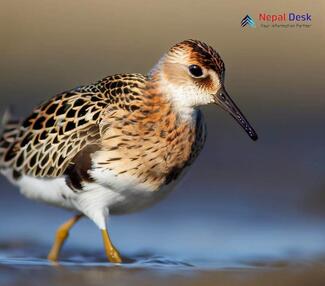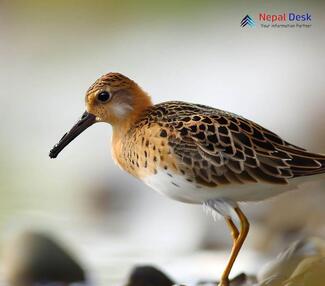The Ruff, Calidris pugnax, is a distinctive and fascinating wading bird found throughout various regions across the globe. Boasting a unique combination of features and behaviors, these intriguing creatures have long captured the interest of bird enthusiasts and researchers alike. In this article, we'll explore the taxonomy, physical characteristics, habitat, diet, presence in Nepal, and some interesting aspects that make this species truly remarkable.
Taxonomy of the Ruff
The Ruff belongs to the family Scolopacidae and is classified as Calidris pugnax. First described by renowned Swedish zoologist Carl Linnaeus in 1758, the Ruff shares its taxonomic family with several other wading bird species like sandpipers and snipes. This extensive group of birds is well known for their distinctive appearance, migratory patterns, and exceptional adaptability.
Physical Features
One of the most striking features of the Ruff is its highly variable plumage. Male Ruffs display a wide range of colors and feather patterns during the breeding season. From vividly colored ruffs adorning their neck to extravagantly feathered head tufts, male Ruffs utilize these ornamental displays to attract females.
Female Ruffs, on the other hand, possess more subdued plumage with predominantly brownish-grey tones. Both sexes have medium-length legs well suited for wading in shallow waters in search of food.
Habitat Preferences
The Ruff inhabits a diverse array of habitats that include wetlands, marshes, grasslands, and coastal areas among others. During the breeding season, males seek territories in open areas near water where they can establish lekking sites - communal displays performed to attract females. Throughout the year, their choice of habitat primarily depends on food availability and migration patterns.
Diet of the Ruff
As opportunistic feeders, the diet of the Ruff is as diverse as its habitats. Primarily carnivorous, these wading birds forage mainly on invertebrates such as insects, crustaceans, and mollusks. In some instances, they also consume seeds and aquatic vegetation. The seasonal availability of prey has a significant influence on their feeding habits and movements.
Presence in Nepal
The Ruff is a regular visitor to Nepal, especially during the winter months when migratory birds from colder regions make their way to warmer climates. They can be commonly found in wetland areas throughout the country's lowlands called Terai. National parks such as Chitwan serve as vital birding hotspots where enthusiasts can observe and study these captivating creatures.
Interesting Points:
A remarkable aspect of the Ruff's breeding behavior is its unique system of male strategies: territorial males, satellite males, and female-mimicking "faeders." Territorial males defend small areas within leks while satellite males forego territory ownership but still display and mate with visiting females. Faeders rely on a more secretive approach, disguising themselves as females to gain access to mating opportunities.
In conclusion, the Ruff (Calidris pugnax) stands out as an intriguing species with rich biological features and intriguing behaviors. From its varied physical appearance to its adaptive and complex social interactions, this wading bird offers a fascinating glimpse into the extraordinary world of avian diversity.




